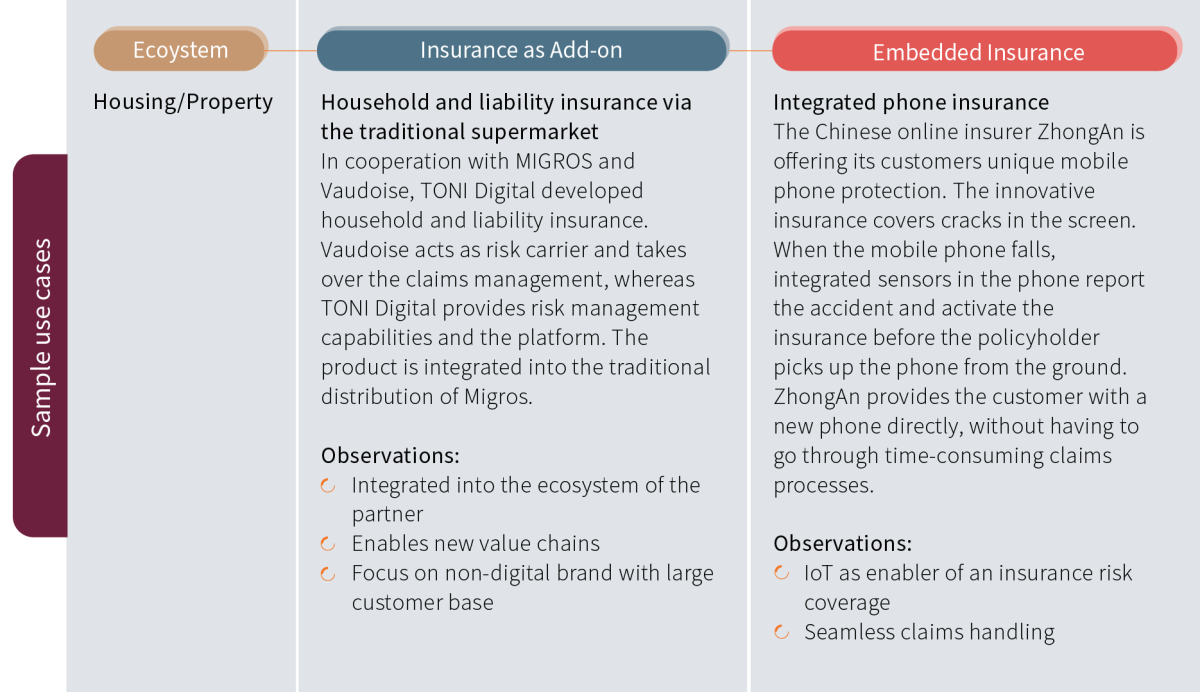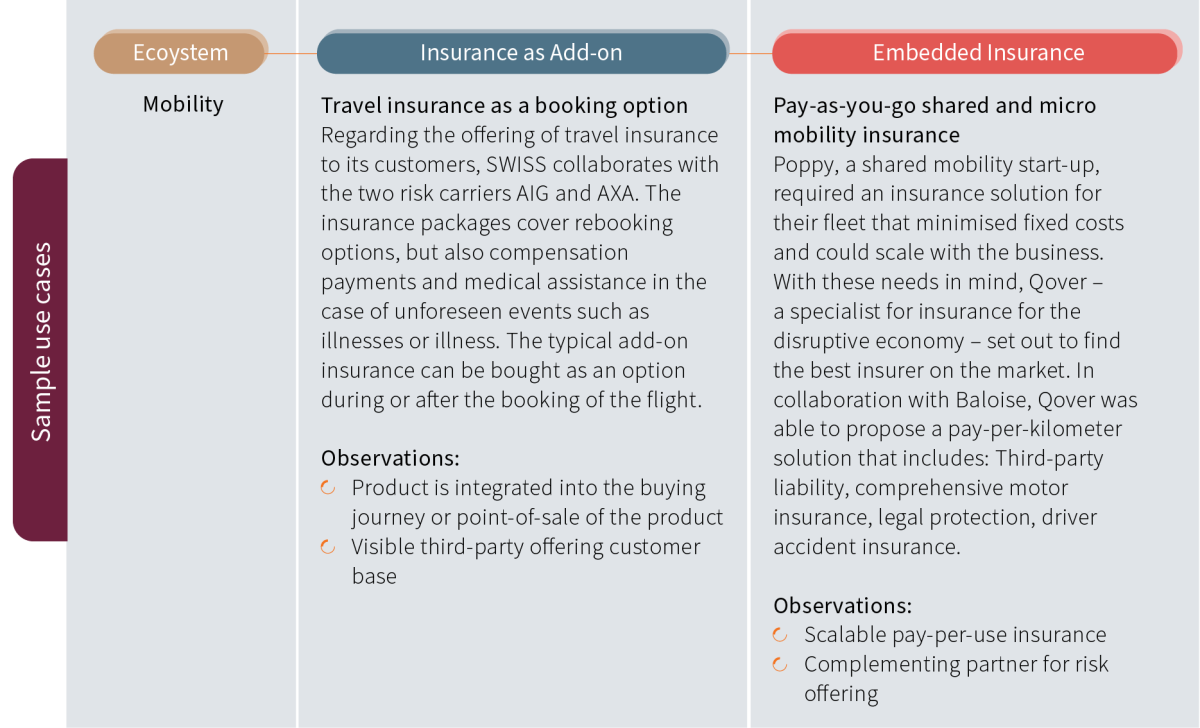Property and casualty (P&C) insurance companies have been making steady gains in the past few years. According to Zippia, from 2017 to 2018, saw an increase in net income from $38.7 billion to $57.9 billion (49.5%)[1]. This can be seen as an opportunity for insurers to sell their products and potentially grow their business. If insurers can seamlessly integrate their products into the customer journeys of third-party providers, they can intercept customers at the point of sale and convince them to purchase their insurance.
Embedded Insurance in a nutshell
One of the most popular subjects in the insurance industry over the past few years has been embedded insurance (EI). EI can enhance partnerships using technology to embed insurance into third-party customer journeys and points of purchase, which open up new business opportunities for insurers.
EI is having a big impact on the market. The growing protection gap between economically and socially beneficial amounts of insurance coverage and actual amounts could be reduced by offering customers appropriate insurance products at exactly the right time and place, resulting in more efficient matches between insurance supply and demand.
Consumers typically do not think first about insurance. That is why traditional insurers had to sell their products aggressively. When insurance is seamlessly integrated into the customer journey, as in the case of EI, customers are less likely to think of insurance as a stand-alone product. This opens them up to more personalised products that fit their lifestyle and a simpler buyer process that matches their time of need. Customers are more likely to purchase insurance when risk is involved.
The importance of EI becomes obvious by looking at the expected P&C market growth of about 25% to BN 573 $USDuntil 2030. EI is predicted to become an important distribution channel, cannibalising the traditional insurance business based on expected very high growth rates. As a result of this fast-pacing development, could gain 24% of Europe’s P&C.[2]
Opportunity for insurers
The EI business model provides a competitive advantage and enables insurers to thrive. Insurers can leverage consumers’ trust and loyalty to known brands when bundling their offerings with consumer brands. This way, insurers get access to millions of potential customers at a time when the marginal cost of insurance is lower due to bundling with high-value items. Furthermore, EI aims to leverage the emotional binding of a customer to the primary product. As a result, the customer is more likely to be willing to insure the item and most probably for even a long-term relationship. Hence, the insurance period also lasts longer, which is attractive for insurers.
Simply put, consumers do not wake up eager to purchase insurance. This means that every distribution channel, including direct-to-consumer, agents, and brokers, bear relatively high costs of client acquisition. EI reduces distribution costs by relying on partner distribution capacity and client relationships, thereby growing new revenue channels.
EI solutions also provide data that helps insurers better understand customer behavior, enabling more relevant and personalised products. This data is often leveraged from IoT or telematics, mobile devices as well as online marketplaces or social media platforms and provide insurers with behavioural and usage-based data that exceeds the so far available core insurance data. This in return can yield cross- and upselling potential or even the invention of new risks. There are emerging markets and products that the consumer had not even considered being insured. At the same time, more data enables more adequate risk assessment and pricing of to-be-insured objects and persons, resulting in more competitive prices.
Where and how to start
Putting complicated insurance products on a webpage will not work with EI. EI products must be simplistic and easily understood, with only a few variations. The buying process must be simple, with few inquiries, uninterrupted, and leading to a real-time policy. Many traditional insurers have already made some progress in developing these capabilities.
In summary, there are five key requirements for EI products and propositions when entering the EI market:
- Product simplicity
- Integration into the buying journey of the primary product
- Easy claims process
- Complementing partners
- Potential for large risk volumes and/or big risk value
Although EI's potential applications are broad, it is advisable to decide on one ecosystem. Once the service is developed, insurers can leverage the capability built in other ecosystems as well. Synpulse closely observes the ongoing establishment of ecosystems in mobility, property, health, and cyber.
Solutions can be offered as complementary add-ons to the core offering of third-party business at point-of-sale. However, this is not truly EI but rather a preliminary form of it. Add-on insurance could be seen as an intermediary form between direct insurance and integrated insurance. The differences to true EI are highlighted in the table below.
Another way to place solutions can be an invisible native component of a broader third-party offering. These often cover costs that were previously uninsured or only insured to a limited extent. This can enable business models that were previously not possible.
Insurers must answer important questions about “where,” “how,” and “with whom to play.” EI is about finding the ideal distribution partner for plug and play insurance as well as the ideal customer types to place the products. To demonstrate how insurance can be embedded into customer journeys, below are some sample use cases.



Resume and offering
As seen in these use cases, EI has many dimensions like distribution, products, or technology. Insurers must adapt products for embedding while traditional affinity and distribution partners extend their business to be able to stay competitive. At the same time, managing general agents (MGAs) and insurtechs offer their capabilities and services to brands and insurers, who want to embed insurance.
Insurers have to develop an embedded strategy today, with a realistic understanding of their current position and a path to transformation. Traditional insurers must address:
- Which target role (aggregator, supplier, or orchestrator) to play in the EI space?
- How to adapt the business and customer journey to stay competitive in changing markets?
- Which partnerships will expand distribution channels?
Synpulse is a strategic partner of insurance companies, offering consulting services, including for EI, within the Global Insurance Market. We conjointly elaborate an appropriate strategy to become a relevant player in the EI business. Our market experience in developing an MVP for traditional insurers combined with EI partners makes us an early-mover in this topic. We focus on the optimisation of your Operating Model, Target Business & IT Architecture landscape, as well as Transformation roadmap towards EI excellence. Our developed mature assets such as the market radar and the capability and maturity assessment support our approach and make us an ideal partner for you.
Reach out to us if you’d like to find out how we can support you with your business case.
1 Simon Torrance (4 January 2021), “Embedded insurance: a $3tn market opportunity, that could also help close the protection gap”
2 Vaudoise (25 May 2021), "Die Vaudoise und die Migros arbeiten zusammen beim Vertrieb von digitalen Versicherungslösungen"
3 InsurTech World (22 December 2021), "Embedded Insurance – Where Are We Now?"
4 SWISS, "The right insurance cover for your trip"
5 Qover, "Poppy: shared and micromobility insurance"
6 Bsurance, "Short-term ski-accident insurance with immediate coverage and activation via smartphone - directly at the ski lift"
7 Bsurance, "A specially developed parametric dental insurance with insurance benefits depending on the tooth brushing behaviour"



